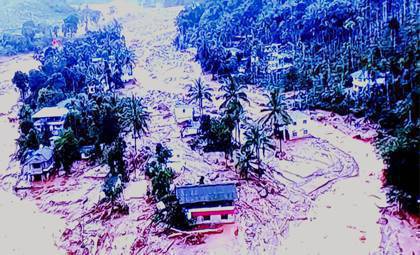


On a fateful day in August 2024, the serene landscape of Wayanad, a picturesque district in the Western Ghats of Kerala, India, was shattered by a catastrophic landslide. The incident, which claimed over 300 lives, was not just a tragic loss of human life but also a grim reminder of the vulnerabilities faced by regions prone to natural disasters. This article delves into the causes, impacts, and the broader implications of the Wayanad landslide, while also examining the response and the lessons to be learned for future disaster management.
Wayanad: A Vulnerable Landscape
Wayanad, known for its lush greenery, coffee plantations, and rich biodiversity, is situated in the Western Ghats, a UNESCO World Heritage Site. The region is characterized by steep slopes, heavy monsoonal rains, and a history of geological instability, making it susceptible to landslides. The dense forests and high rainfall contribute to the erosion and weathering of rocks, which can lead to sudden slope failures.
In recent years, Wayanad has witnessed an increase in deforestation, unregulated construction, and changes in land use patterns, exacerbating the region's vulnerability. The combination of natural and anthropogenic factors set the stage for the devastating landslide.
The Catastrophic Event
On 30th July several landslides hit Mundakkai, Chooralmala, and Meppadi villages of Wayanad district.The situation was aggravated by
heavy rains which pounded Wayanad, a familiar monsoon phenomenon. However, the intensity and duration of the rainfall were unprecedented, triggering a massive landslide in the Meppadi area. The saturated soil, unable to hold its weight, slid down the slopes, engulfing everything in its path—homes, roads, and people.
These landslides, which stretched over several kilometers, struck with little warning. Residents had little time to react as the massive wall of mud, rocks, and debris swept through villages. The sheer force of the landslide uprooted trees, buried homes, and wiped out entire communities. Rescue operations were hampered by the difficult terrain and continuous rainfall, making it a race against time to find survivors.
Human and Ecological Toll
The human cost of the landslide was staggering. Over 300 people lost their lives, with many more injured or missing. Entire families were wiped out, leaving behind a trail of grief and despair. The loss extended beyond human lives, as livestock perished, homes were destroyed, and livelihoods were disrupted. The psychological trauma experienced by the survivors, many of whom lost loved ones and everything they owned, cannot be overstated.
Ecologically, the landslide caused significant damage to the rich biodiversity of the Western Ghats. Large swathes of forest cover were lost, disrupting the habitat of numerous species. The landslide also impacted water sources, with debris clogging rivers and streams, affecting water quality and availability.
Factors Contributing to the Landslide
Several factors contributed to the Wayanad landslide, both natural and man-made. The heavy rainfall, a result of a strong monsoon system, was the immediate trigger. The region had received over 300 mm of rainfall in just 24 hours, saturating the soil and increasing the likelihood of slope failures.
However, underlying these natural causes were several human-induced factors. Deforestation, primarily for agriculture and development projects, had weakened the soil structure. The removal of trees, which play a crucial role in stabilizing soil, made the slopes more susceptible to landslides. Additionally, unregulated construction, including roads and buildings on steep slopes, further destabilized the area. Poor land use planning and a lack of adherence to building codes exacerbated the risk.
Climate change also played a role in the disaster. The increasing frequency and intensity of extreme weather events, including heavy rainfall, have been linked to global climate change. Kerala, including Wayanad, has witnessed a shift in monsoon patterns, with shorter, more intense bursts of rain. This changing climate scenario poses new challenges for disaster preparedness and response.
Response and Rescue Operations
The response to the Wayanad landslide was swift but challenging. The National Disaster Response Force (NDRF), along with the Indian Army, local police, and volunteers, launched a massive search and rescue operation. Helicopters were deployed to airlift stranded individuals, and teams worked tirelessly to locate survivors buried under the debris.
However, the efforts were hampered by the difficult terrain and continuous rainfall, which made access to affected areas challenging. Landslides and flooding blocked roads, delaying the arrival of rescue teams and supplies. The lack of proper infrastructure in the region further complicated the response efforts.
The local community played a crucial role in the immediate aftermath of the disaster. Neighbors helped each other, providing shelter, food, and emotional support. Local organizations and NGOs quickly mobilized resources, setting up relief camps and distributing essential supplies. Despite these efforts, the scale of the disaster overwhelmed the available resources, highlighting the need for better preparedness and infrastructure.
Long-term Impacts and Rehabilitation
The long-term impacts of the Wayanad landslide are multifaceted, affecting the social, economic, and environmental aspects of the region. The loss of life and property has left many families in a state of despair and financial insecurity. The destruction of homes and infrastructure has displaced thousands, forcing them to live in temporary shelters with limited access to basic amenities.
Rebuilding efforts are expected to take years, with significant resources needed to restore infrastructure and provide housing for the displaced. The economic impact is also profound, as agriculture and tourism, the primary sources of livelihood in the region, have been severely affected. Coffee and spice plantations, which are the backbone of Wayanad's economy, have suffered extensive damage, affecting the income of thousands of farmers.
The environmental impact is equally concerning. The loss of forest cover and biodiversity could have long-term consequences for the region's ecological balance. The disruption of water sources could lead to water scarcity, affecting both agriculture and drinking water supply. Efforts to restore the natural habitat and prevent further environmental degradation will be crucial in the coming years.
Lessons Learned and the Way Forward
The Wayanad landslide has underscored the urgent need for comprehensive disaster management and climate adaptation strategies. Several lessons can be drawn from this tragedy:
1. Improved Early Warning Systems: There is a critical need to enhance early warning systems for landslides and other natural disasters. Real-time monitoring of weather patterns, soil moisture levels, and seismic activity can help provide timely warnings and potentially save lives.
2. Sustainable Land Use Planning: The disaster highlights the importance of sustainable land use planning and regulation. Deforestation, unregulated construction, and poor land management practices must be addressed to reduce the risk of landslides. Strict enforcement of building codes and zoning regulations is essential to prevent construction in vulnerable areas.
3. Climate Adaptation: As climate change increases the frequency and intensity of extreme weather events, there is a need to integrate climate adaptation measures into disaster management plans. This includes building resilient infrastructure, promoting sustainable agricultural practices, and conserving natural ecosystems.
4. Community Involvement and Capacity Building: Local communities are often the first responders in the aftermath of a disaster. Strengthening community capacity through education, training, and resources can enhance local resilience. Public awareness campaigns on disaster preparedness and response can empower communities to take proactive measures.
5. Strengthening Disaster Response Infrastructure: The challenges faced during the rescue and relief operations underscore the need for robust disaster response infrastructure. This includes better road connectivity, communication networks, and emergency facilities. Investment in these areas can improve the efficiency and effectiveness of disaster response efforts.
6. Post-Disaster Rehabilitation and Recovery: Long-term rehabilitation and recovery efforts must prioritize the needs of affected communities. This includes providing adequate housing, healthcare, and livelihood support. Environmental restoration and conservation efforts should also be a key focus to ensure the sustainable recovery of the region.
7. Increase the forest cover- The forest cover in Vaynad has decreased to very low.The quality of forest cover is low.Foreign plants like cofee plantation with swallow roots are of little help.We must replant local trees with deep
Conclusion
The Wayanad landslide of 2024 stands as a tragic reminder of the fragile balance between human activities and the natural environment. While natural disasters are an inevitable part of life, their impact can be mitigated through proactive measures and sustainable practices. The lessons learned from this disaster should serve as a catalyst for change, prompting authorities, communities, and individuals to work together towards a safer and more resilient future.
As the people of Wayanad rebuild their lives, the focus must be on not just recovery but also on building back better. By embracing sustainable development and prioritizing disaster preparedness, we can ensure that such tragedies become less frequent and less devastating. The resilience of the people of Wayanad, their courage, and their determination to rebuild is a testament to the human spirit's strength in the face of adversity. It is now up to all stakeholders to support them in this journey and to take the necessary steps to prevent future disasters.